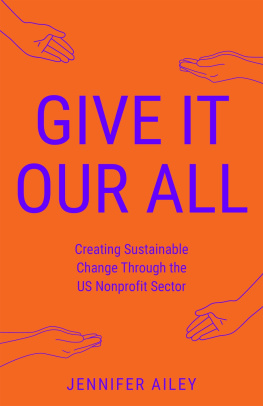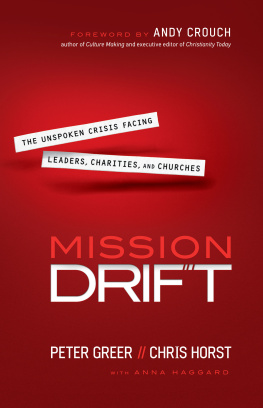Copyright 2013 by Kenneth Stern
All rights reserved. Published in the United States by Doubleday, a division of Random House, Inc., New York, and in Canada by Random House of Canada Limited, Toronto.
www.doubleday.com
DOUBLEDAY and the portrayal of an anchor with a dolphin are registered trademarks of Random House, Inc.
Jacket photograph and design by Oliver Munday
Library of Congress Cataloging-in-Publication Data
Stern, Ken, [date]
With charity for all : Why charities are failing and a better way to give / by Ken Stern.1st ed.
p. cm.
Includes bibliographical references.
1. CharitiesUnited States. 2. Nonprofit organizationsUnited StatesEvaluation.
3. HumanitarianismUnited States. I. Title.
HV91.S649 2013
361.76320973dc23
2012028803
eISBN: 978-0-385-53472-7
v3.1_r1
For my son, Nate,
who will someday write books of his own
CONTENTS

INTRODUCTION

W HEN THE F RENCHMAN Pierre LEnfant laid out his plans for the new District of Columbia in 1791, he designed Sixteenth Street to be one of the grand avenues of the new capital. Two hundred and twenty years later, his vision has been mostly realized. Sixteenth Street rises from the foot of the White House, runs north past luxury hotels, rows of embassies, the blank faade of the national headquarters of the Freemasons, through parks and the prosperous leafy neighborhoods of Washingtons Gold Coast, up past Walter Reed Hospital, before reaching a tired ending among the down-market strip malls and mini-marts of Silver Spring, Maryland. At key points, it commands sweeping views not only of the White House but of the Washington Monument and the Jefferson Memorial beyond.
Living in the Mount Pleasant section of Washington, I frequent a stretch along this storied street. From my home, its a fifteen-minute walk along Sixteenth Street to our local grocery store. Along the way, I pass some of the landmarks of the neighborhood: the All Souls Unitarian Church, the Little Flower Montessori School, the Scottish Rite Temple, a dormitory for Howard University students. In a span of about eight blocks, I pass no fewer than sixteen nonprofit organizations: five churches, four educational institutions, five social service organizations, one credit union, and one fraternal organization.
Most people would be hard-pressed to name sixteen charities, but in fact my little trip is not that unusual. Every day our lives are touched by the charitable sector. To the extent that we think about charities, we tend to associate them with services for the poor and the dispossessed. But the charitable sector is much more than that. It educates our young; it takes care of our old and infirm; it fields the teams that we cheer for on Saturdays and serves up spiritual sustenance on Sundays; it provides much of the intellectual and cultural nourishment for this country. The nonprofit community occupies some of the most sacred real estate in our public square and cushions some of our most important private and intimate moments. We entrust our children and our parents to it, and it is often the first and most important responder in times of crisiswhether those crises are personal in nature or global in reach.
There are approximately 1.1 million charities in this countrynot local chapters, but unique, full-fledged organizations. And this percentage is certain to grow as the challenges of our society multiply and government proves unable to respond in a meaningful way.
Almost all of us are engaged in the charitable sector in direct ways: as employees, as volunteers, as donors, or as customers and clients. And even those few not so involved are indirectly entangled as taxpayers and citizens. While considerable funding for charities comes These same governments also provide an enormous amount in indirect support by exempting charities from income and property taxes and providing deductions for charitable donations. Even in this age of multitrillion-dollar government budgets, that indirect support is significant. If we chose to eliminate or even cap just these exemptions, our public coffers would swell by tens of billions of dollars yearlyin line with the entire federal appropriation for housing and education.
The charitable sector is one of the anchors of American public life. Its vast scope makes any quick catalog of its functions incomplete, but it includes areas as diverse as education, global health services, shelter for the homeless, preservation of public and private land, athletics, arts and culture, and some of our most important scientific research. We support this broad array of services because absent a robust charitable economy, these functions would either cease or devolve to governmentan unpalatable option in a time of rising public debt and dwindling faith in the efficacy of government. In effect, we have privatized these public functions in the belief that charities can perform these tasks better and with greater efficiency than government. The publicand privateinvestment in the social sector is one of the critical elements of the American social compact, yet it is one of the oddities of public life that each year we renew this investment without ever pausing to ask the same questions that we ask of every other public and private investment: What are we getting in return, is the investment structured correctly, is the money going to the right places? Remarkably, we dont think much about the nonprofit sector at all. Our attention to it is largely scandal-driven (think of the United Way and ACORN) and ephemeral, due to a web of factors including the cloaked nature of the public investment, the fact that the public rarely perceives the millions of disparate charitable businesses to be a unified industry, and the fact that the sector includes sacred institutions of American life such as churches and schools.
We live in a society that is obsessed with resultsfrom businesses, from government, from sporting events. Markets are endlessly debated, scrutinized, reduced to reams of data. Governments rise and fall on issues of accountability and results. Managers are fired, players traded, teams dismantled if a squad falls short of the expectations of ownership or of fans. Yet in this results-obsessed country, the public rarely demands measures of how effective charities are in implementing their services and meeting their service goals. And, as we shall see throughout this book, when the public generally and funders more specifically do not press for results-oriented organizationsand indeed value qualities that are inversely related to effectivenesscharities respond accordingly. The implications are extensive, not just for the prudent use of resources, but for how we as a society tackle our most challenging problems and how we serve the poor, the infirm, the hungry, the homeless, and others who do not have full voice in our public life. This books story of charitable ineffectiveness is not one of greed or incompetencethough there are chapters on thatbut one of misguided incentives and failed market structures. And it begins with one of the most venerated names in American charity.













